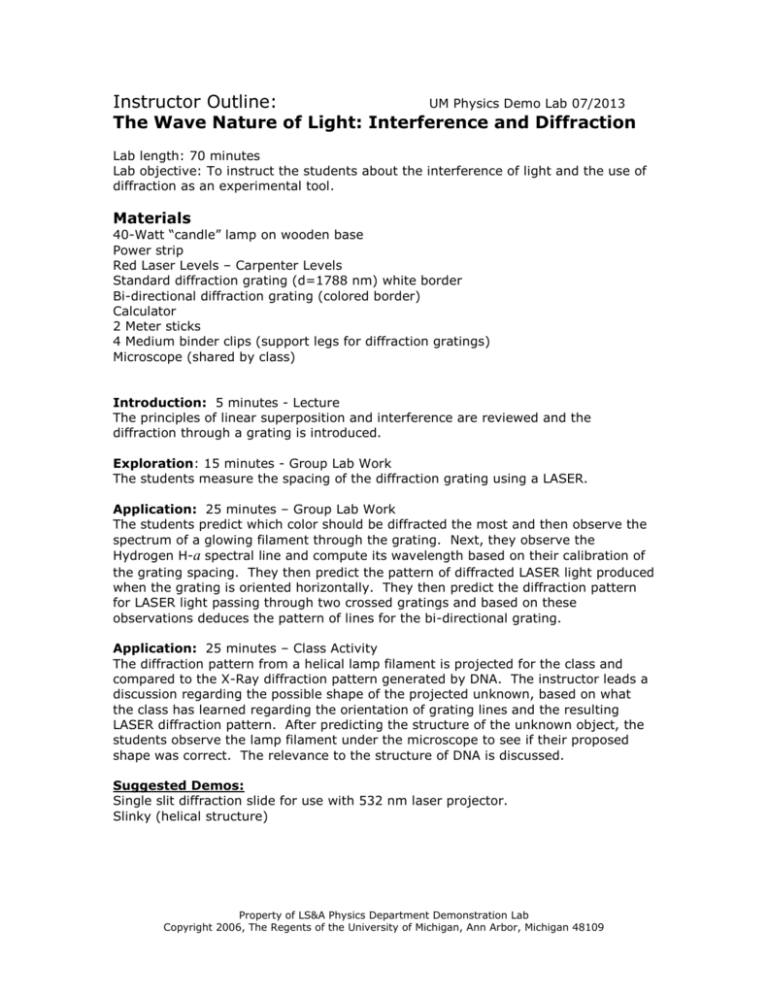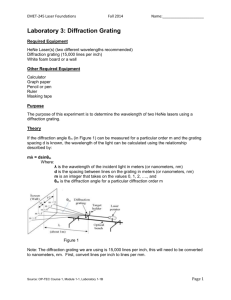Optics-Diffraction - Instructor Outline
advertisement

Instructor Outline: UM Physics Demo Lab 07/2013 The Wave Nature of Light: Interference and Diffraction Lab length: 70 minutes Lab objective: To instruct the students about the interference of light and the use of diffraction as an experimental tool. Materials 40-Watt “candle” lamp on wooden base Power strip Red Laser Levels – Carpenter Levels Standard diffraction grating (d=1788 nm) white border Bi-directional diffraction grating (colored border) Calculator 2 Meter sticks 4 Medium binder clips (support legs for diffraction gratings) Microscope (shared by class) Introduction: 5 minutes - Lecture The principles of linear superposition and interference are reviewed and the diffraction through a grating is introduced. Exploration: 15 minutes - Group Lab Work The students measure the spacing of the diffraction grating using a LASER. Application: 25 minutes – Group Lab Work The students predict which color should be diffracted the most and then observe the spectrum of a glowing filament through the grating. Next, they observe the Hydrogen H-а spectral line and compute its wavelength based on their calibration of the grating spacing. They then predict the pattern of diffracted LASER light produced when the grating is oriented horizontally. They then predict the diffraction pattern for LASER light passing through two crossed gratings and based on these observations deduces the pattern of lines for the bi-directional grating. Application: 25 minutes – Class Activity The diffraction pattern from a helical lamp filament is projected for the class and compared to the X-Ray diffraction pattern generated by DNA. The instructor leads a discussion regarding the possible shape of the projected unknown, based on what the class has learned regarding the orientation of grating lines and the resulting LASER diffraction pattern. After predicting the structure of the unknown object, the students observe the lamp filament under the microscope to see if their proposed shape was correct. The relevance to the structure of DNA is discussed. Suggested Demos: Single slit diffraction slide for use with 532 nm laser projector. Slinky (helical structure) Property of LS&A Physics Department Demonstration Lab Copyright 2006, The Regents of the University of Michigan, Ann Arbor, Michigan 48109 Concepts developed: 1. Light exhibits both wave-like and particle-like behaviors. 2. The principle of linear superposition says that the amplitudes of two or more waves arriving at a point in space add at every instant of time. This gives rise to interference, where two or more arriving waves add up to larger amplitude, smaller amplitude or zero. 3. Waves which encounter structures small compared to their wavelengths undergo diffraction whereby they bend around corners or obstacles. 4. Light waves projected through a slit narrower than the wavelength will interfere to produce a pattern of alternately light and dark fringes. 5. A diffraction grating consists of many narrow parallel slits and disperses light into its component wavelengths (colors). Each wavelength of light will diffract to a specific angle after passing through the grating. 6. A diffraction grating can be used to measure the wavelength of atomic emission lines. This application of diffraction is called spectroscopy. 7. Conversely, the diffraction of a monochromatic (one color—one wavelength) beam of LASER light can be used to measure the spacing of a diffraction grating. 8. Diffraction of monochromatic light from a LASER or X-Ray source can be used to infer the size and structure of small objects, crystals and molecules. Small structures produce large diffraction angles; large structures produce small diffraction angles. Property of LS&A Physics Department Demonstration Lab Copyright 2006, The Regents of the University of Michigan, Ann Arbor, Michigan 48109









